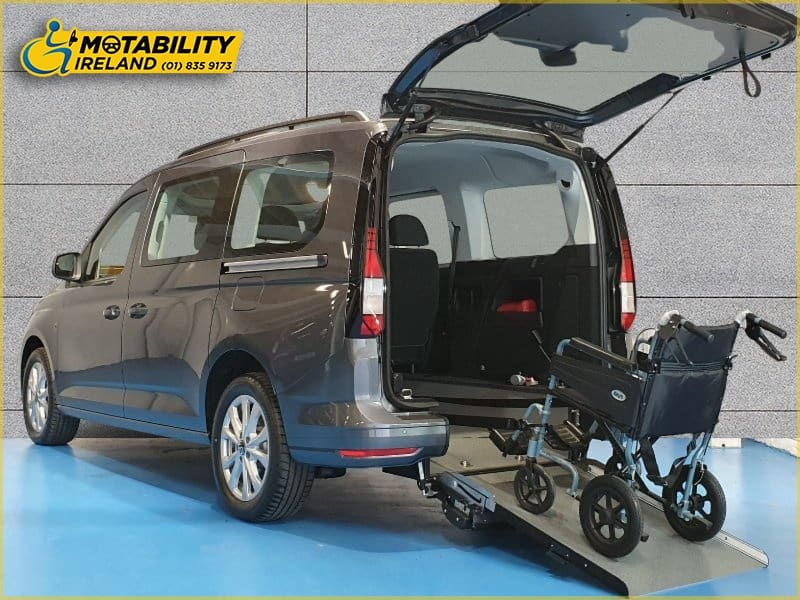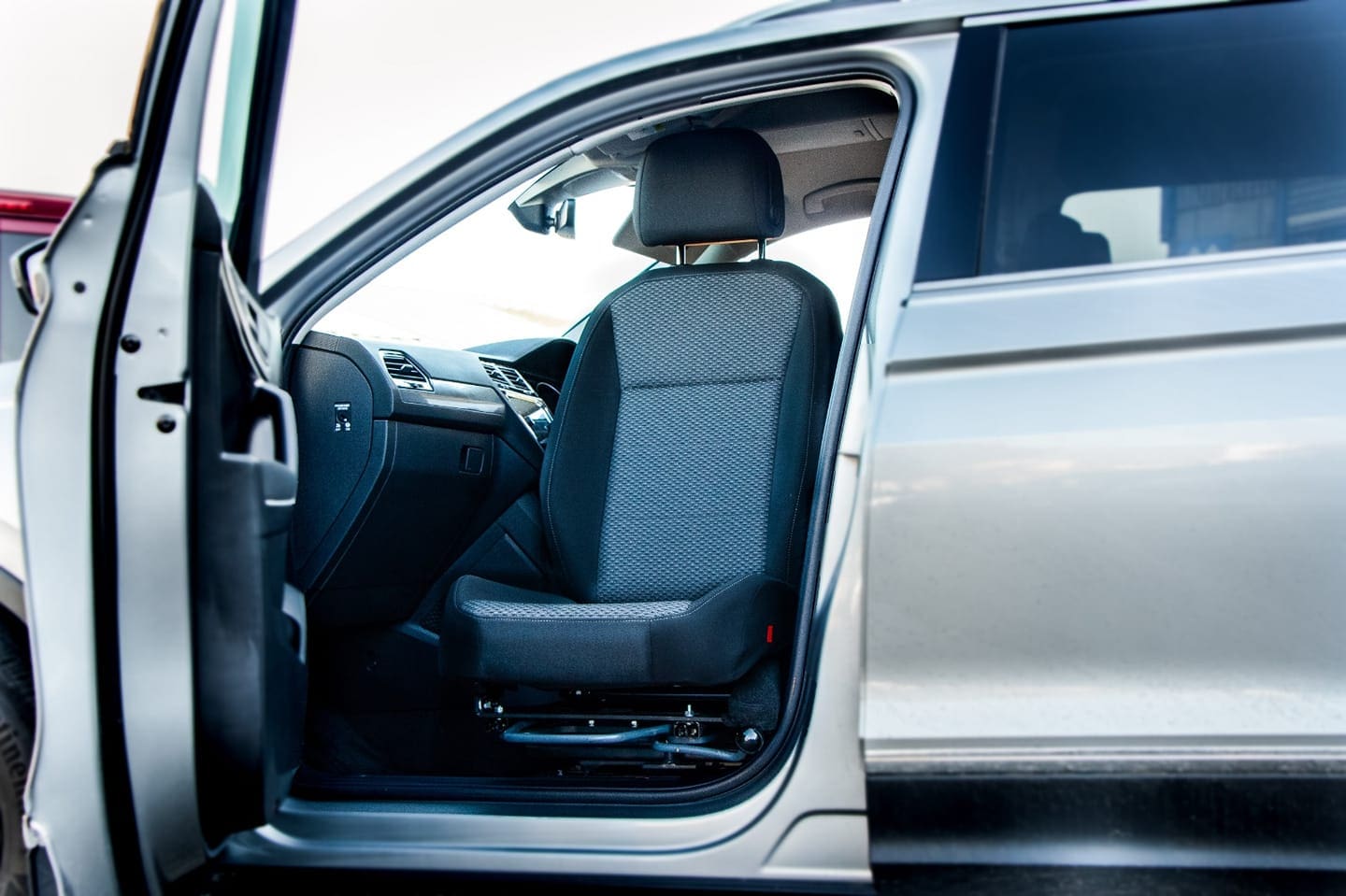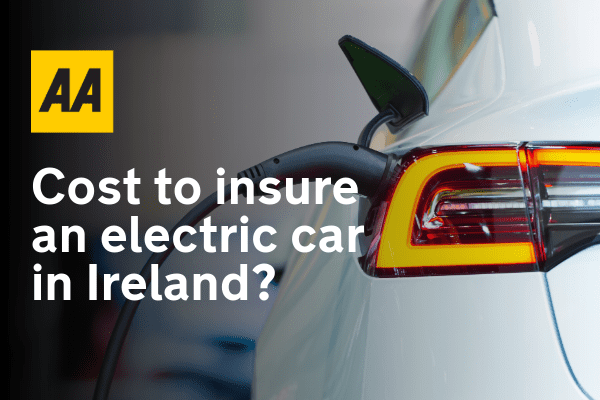There have never been so many ways to adapt vehicles for drivers and passengers with disabilities or reduced mobility. From specially adapted vehicles with different controls for drivers, to wheelchair accessible vehicles with or without lifts, there are more options than ever. However, choosing the right vehicle and the right adaptation can seem daunting, and that’s before you think about getting all your paperwork lined up.
This week, The AA’s Lauren Beehan spoke to the Disabled Drivers Association of Ireland and visited Motability Ireland’s vehicle adaptation showroom in Ashbourne to find out what’s available.
The first thing Aaron Taylor from Motability Ireland tells us is that there is no cookie-cutter one-size-fits-all vehicle for their customers. When someone comes to Motability for an adapted vehicle or a conversion, the team will start by asking them a lot of questions. This is not just to be nosy, as Aaron is keen to point out, but because they need to make sure that they can offer exactly the right vehicle or the adaptation for the person’s individual needs.
“There’s no vehicle unfortunately that suits all. As we like to say, we’re not like a normal car dealership – you can’t come in here and we’ll go ‘This car here looks good, this’ll suit you!’. That’s not the way that we operate. The reason you’re here is for the person in the wheelchair, and if the vehicle isn’t suited for that person, there’s no point to having the conversation. Aesthetics, obviously, is a nice advantage with the vehicle, but the practicality is the real reason, so we assess what is suitable for the person.”
This is echoed by Richard Ryder from the Disabled Drivers Association of Ireland: “We would always tell them, before they do anything, to go and get professional advice, because it will save you big time in the long run. Disability a very individual thing, so not one size fits all.”
Who are adapted or converted vehicles for?
Vehicles can be adapted specifically for a person who uses a wheelchair, with different options depending on:
- the type of wheelchair they use,
- whether they are going to be the driver or a passenger,
- if they want to install a hoist or lift to assist them entering the vehicle, and
- whether they will be travelling in the wheelchair within the vehicle, or transferring to the vehicle seats and stowing their wheelchair away.
Motability sell a range wheelchair accessible vehicles (WAVs) designed to be used by drivers, by families, and as taxis. Separately, they also do driver adaptations for all types of limb disabilities or reduced mobility, including of the arms or hands.
Richard from the DDAI says they provide assistance and advice to “lots of different people at different stages of their lives”. That includes people with a disability who wish to start driving for the first time, those returning to driving with a different level of mobility after an illness or injury, and those who wish to continue driving into old age. The DDAI also runs the “blue badge” accessible parking scheme, provides driver assessments, and advises on all aspects of driving with a disability via their website and webinars.

So, what adaptations are possible?
Jonny Moore, Motability’s general manager, tells us there is a wide range of options, depending on the person’s needs. “An example of a disabled passenger could be someone who’s looking for a basic swivel seat. On the driver’s side, we have anywhere from a steering ball up to space drive systems to help them brake and accelerate the vehicle.”
The swivel chair is one of the most popular adaptations they do on the passenger side of the car – a simple change that allows a car seat to turn 90 degrees to face the door. This make it easier for those with reduced hip mobility to sit into the vehicle, and then turn to the front.
For drivers with a disability or reduced mobility in one or more limbs, there are lots of different ways that the vehicle can be made more easily driveable. Aaron shows us a car that has been fitted with hand controls: a lever is installed beside the steering wheel, which you pull for the accelerator and push for the brake. It has a finger switch on top for the indicators. Generally when hand controls are installed, the pedals also remain useable. This means the driver who uses hand controls can also allow a family member or other named driver to drive the same car using the traditional foot pedals. Pedal guards can be installed to prevent accidental brushing against the pedals while hand controls are being used.
They can also install a steering ball on the wheel with secondary controls – wipers, lights etc – or have them as infrared switch controls, so they can be operated easily with the fingertips without moving your hand far from the wheel. Separately, there’s the option of a left-foot accelerator for those who don’t have full use of their right leg.
Many of these can be installed in a standard car – the demonstration vehicle we’re shown is a Volkswagen Tiguan – but some adaptations will require a certain amount of head space or a minimum door width, for example. As such, it’s better to approach the adaptors before purchasing a new car, as they can advise on which vehicle type and size suit best.
Wheelchair accessible vehicles
Motability sell new and pre-owned wheelchair accessible vehicles (WAVs) with a variety of different seating configurations. These are larger vehicles that allow a passenger to enter the vehicle in their wheelchair, and safely remain in the wheelchair while travelling. If a vehicle is for a family, it can be configured to have 3 or 4 seats, with the passenger using their wheelchair in the middle, to make conversation easier. If it’s destined to be a wheelchair accessible taxi, it will have five seats and a dedicated wheelchair space in the third row.
They also specialise in drive-from-wheelchair vehicles, and vehicles that allow a driver who uses an electric wheelchair to dock and change seats within the vehicle itself. In these bigger vehicles, they lower floors and install wheelchair ramps into the back.
There are a variety of lifts, winches and hoists that can be installed too. These can be used to assist a person to enter the vehicle while using a wheelchair, and/or to make it easier to stow the wheelchair away if they’re transferring to the car’s own seats.

What financial supports are available for the costs?
The cost of an adaptation very much depends on what you need done – whether it’s adding a hand-control lever, installing a swivel seat, or buying a fully fitted wheelchair accessible vehicle.
The Drivers and Passengers with Disabilities Tax Relief Scheme allows VRT relief and VAT refund of up to €10,000 (combined) for a driver with a disability, and up to €16,000 for a passenger. Those on the scheme are also exempt from motor tax and tolls, and can get a refund on fuel duties too. The team at Motability can advise customers on this scheme, and guide them with the purchase of vehicles that meet the regulations, such as the engine size limit.
The Disabled Drivers Association also provide advice on the scheme and how to apply, including this breakdown on their website. Richard Ryder said, though, that the scheme needs to be reviewed by government: it can be difficult to get onto, with strict criteria covering only 6 types of disabilities. Anyone intending to sign up for it needs a Primary Medical Certificate from the Senior Medical Officer at their local HSE office.
Ryder also says the scheme needs to be modernised, particularly to take into account the advent of electric vehicles. As some VRT relief already exists for EVs, and there are no fuel duties, the benefits of the scheme are limited when it comes to offsetting costs of purchasing an adapted EV.

What else do I need to know about vehicle adaptation?
It’s worth reiterating that vehicle adaptations are not something you should “go it alone” on – you shouldn’t attempt your own bespoke conversion, or buy products and get an electrician friend to install them for you. All vehicle adaptations have to be made by an approved adaptor, like Motability Ireland, which are listed on the NSAI website. This is for safety reasons, to ensure the vehicle remains safe and roadworthy.
All adapted vehicles need an Independent Vehicle Approval certificate – your approved adaptor will apply for this for you. Your insurer will also request a copy, and may require photos of the vehicle too. Certain adaptations can lead to a change of classification with Revenue as an M1 Special Purposes Vehicle.
It’s a good idea to check out insurance options in advance – talk to your insurer or broker if you have one, or get a few quotes first. It’s better to have this sorted before starting the conversion, to avoid complications when it’s finished.
Finally, remember that things are improving and changing all the time, so it’s always worth checking out what’s come onto the market since you last purchased or converted a vehicle. The team in Motability say the main reason their founder Malachy McElmeel set up shop in 1999 was because he saw how little was available on the market for disabled Irish drivers and passengers at that time. Now the business has grown to encompass so many different types of adaptations, and even provides a hire fleet of accessible vehicles.
“Over the past 20, 25, 30 years, [the change] has been huge,” says Richard Ryder from the DDAI. ”Technology now is incredible and it’s only getting better.”
See the full video from our visit to Motability:









